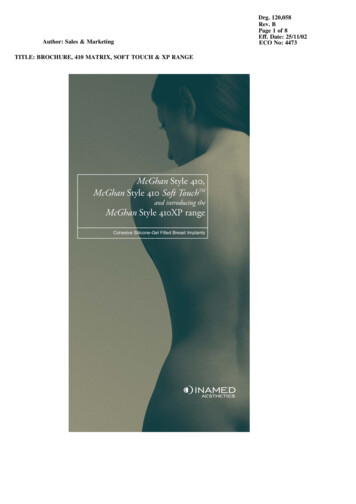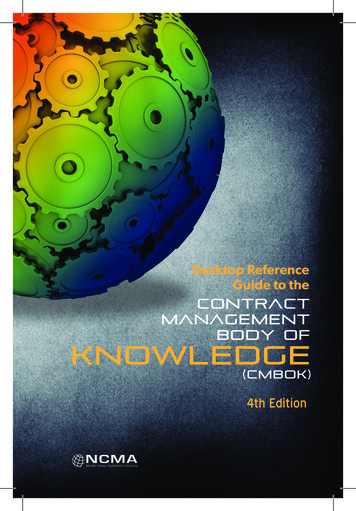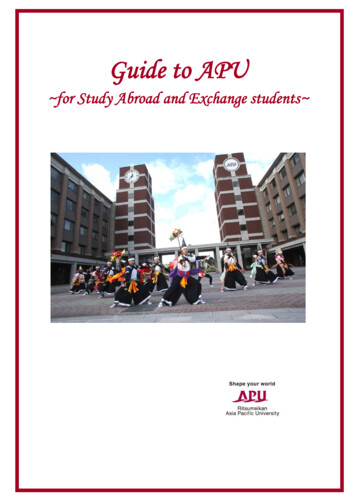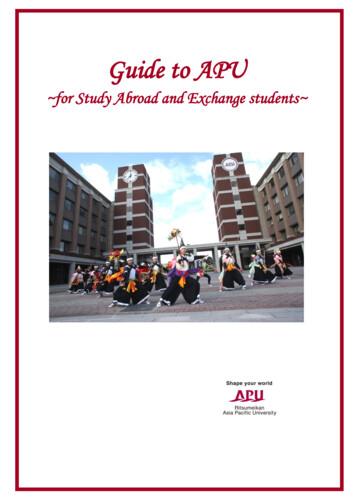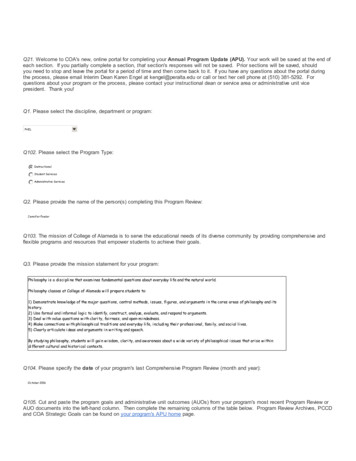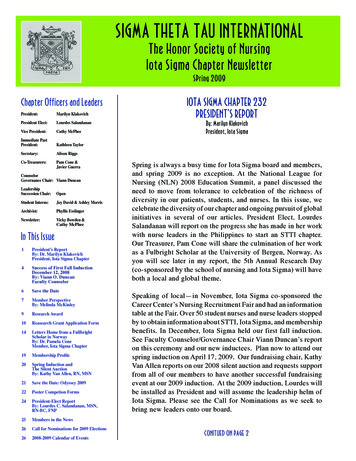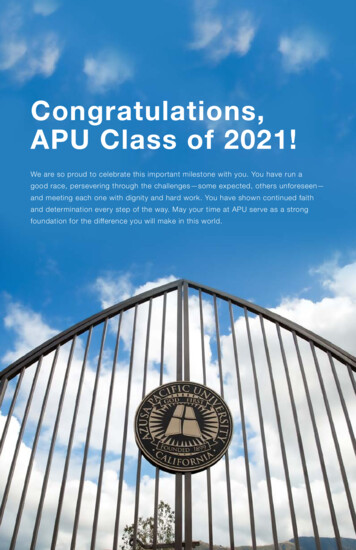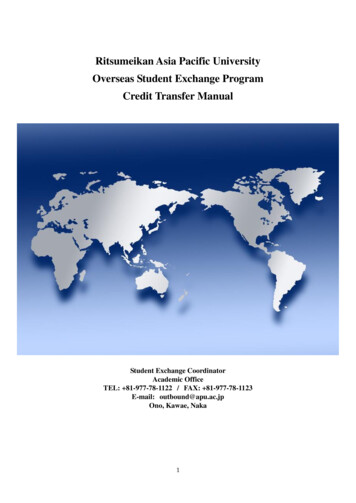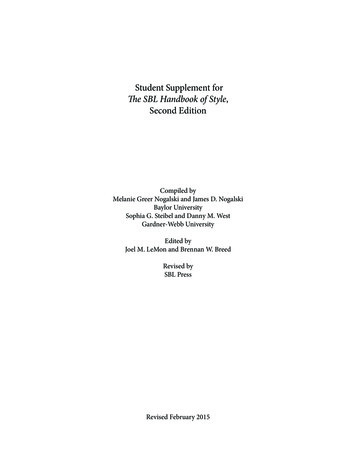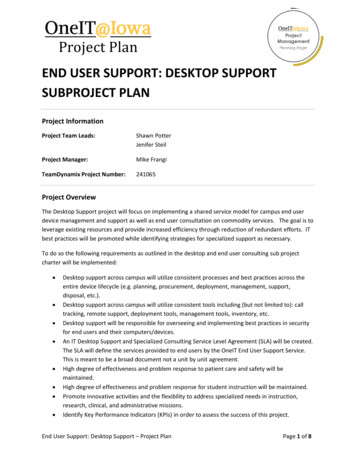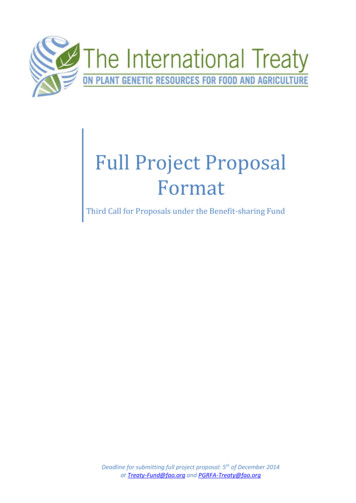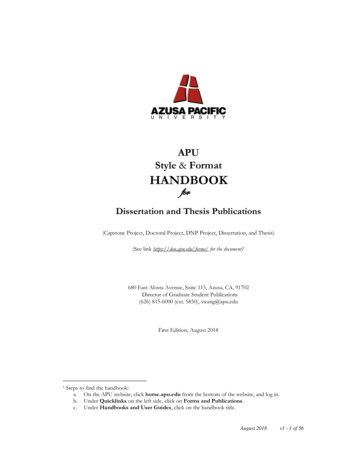
Transcription
APUStyle & FormatHANDBOOKDissertation and Thesis Publications(Capstone Project, Doctoral Project, DNP Project, Dissertation, and Thesis)(See link https://den.apu.edu/forms/ for the document)1680 East Alosta Avenue, Suite 115, Azusa, CA, 91702Director of Graduate Student Publications(626) 815-6000 (ext. 5850), swang@apu.eduFirst Edition, August 20181Steps to find the handbook:a. On the APU website, click home.apu.edu from the bottom of the website, and log in.b. Under Quicklinks on the left side, click on Forms and Publications.c. Under Handbooks and User Guides, click on the handbook title.August 2018v1 - 1 of 56
DEDICATIONThis handbook is dedicated to Lillian Wehmeyer, Ph.D. (1934-2005), who was theDoctoral Dissertation Librarian at Azusa Pacific University. Dr. Wehmeyer was aneducator, librarian, mentor, and author who believed in excellence and practiced itconsistently. She is missed by those who knew and loved her.August 2018v1 - 2 of 56
TABLE OF CONTENTSDedication . 2The APU Dissertation and Thesis Publishing Process. 6Style Manuals . 6Copyright Permission and Academic Integrity . 7Fair Use Doctrine . 7Copyright and Plagiarism . 8Additional Copyright Protection. 8Steps after the Oral Defense. 9Finding an External Reader . 10Contact Information for the APU Director of Graduate Student Publications . 11Format of the Document . 12Margins . 12Line Spacing . 12Pagination . 12Head and Subhead Levels . 14Tables and Figures . 14Order of Required and Optional Components . 15Dates Used in the Document . 15Copy Flow . 16August 2018v1 - 3 of 56
General Format Requirements . 16Corrections . 16Submission of the Sample Copy . 17Doctoral Degree Posting Dates. 17Master’s Degree Posting Dates . 17Completion of Signature Pages . 18Fees and Method of Payment for Hard-bound Copies . 19Method of Submission for Hard-bound Copies . 19Paper and Printing . 20Final Review of Paper Copies to be Hard-bound. 20Picking Up Bound Copies . 20Summary of Fees . 21Appendix A: Sample Pages . 22Instructions for the Title Page . 23Title Page Sample . 24Instructions for the Signature Page. 25Signature Page Sample. 27Instructions for the Copyright Page . 28Copyright Page Sample . 29Instructions for the Dedication Page. 30Dedication Page Sample . 31Instructions for the Acknowledgments Page . 32Acknowledgments Page Sample . 33Instructions for the Abstract Page . 34August 2018v1 - 4 of 56
Abstract Page Sample . 35Instructions for the Table of Contents. 36Table of Contents Sample . 38Instructions for the List of Tables (LOT) and/or List of Figures (LOF) . 39LOT/LOF Sample . 40Instructions for the Chapter or Section Title Page. 41Chapter/Section Title Page Sample . 42Instructions for the Appendix Title Page . 43Appendix Title Page Sample . 44Appendix B: Forms.45ProQuest/UMI Links for Online Submissions . 46APU ProQuest Dissertation/Thesis Publishing Order Form . 47APU Order Form for Hard-bound Copies . 48APU Dissertation/Thesis Committee Approval Form . 49APU Dissertation/Thesis Review Chart for Publications. 50APU Dissertation/Thesis Submission Checklist . 52August 2018v1 - 5 of 56
THE APU DISSERTATION2 AND THESIS PUBLISHING PROCESSAll doctoral and master’s students must submit an electronic sample copy in Word2016 or higher of their completed and program-approved doctoral project, dissertation, orthesis to the Director of Graduate Student Publications in order to: 1) receive approval andhave their dissertations or theses published in the ProQuest Dissertation and Theses database;and 2) complete their degrees.The student should be aware that the degree will not be posted to the student’stranscript until the sample copy has been approved by the Director of Graduate StudentPublications and uploaded to the ProQuest database, even if all other degree requirementshave been met. The university reserves the right to refuse any document that does not meetits format requirements or is unsuitable for uploading.STYLE MANUALSThe student’s department indicates which manual is required for his or herdiscipline. Below is a list of recognized manuals in use by APU graduate programs. Whenthe requirements in this document differ from the style manual, this document prevails. Publication Manual of the American Psychological Association (APA 2010, sixth edition)The Chicago Manual of Style (Chicago, 17th edition)The MLA Handbook for Writers of Research Papers (MLA, eighth edition)A Manual for Writers of Term Papers, Theses, and Dissertations: Chicago Style for Studentsand Researchers (also referred to as Turabian, after the original author Kate L. Turabian, 9thedition)SBL Handbook of Style: For Ancient Near Eastern, Biblical, and Early Christian Studies(second edition)The word dissertation in this handbook includes doctoral capstone projects, nursing practice projects,doctoral projects, and dissertations.2August 2018v1 - 6 of 56
COPYRIGHT PERMISSION AND ACADEMIC INTEGRITYCreators of printed materials and non-print media should be acknowledged for theirmaterial, whether it appears in the dissertation or thesis as a quotation, paraphrase, summary,figure, table, or other type of medium to convey information. Copyright law is intended toprotect intellectual property from misappropriation and loss of income to the copyrightholder. Not all material falls within copyright law; its age is one factor. In addition, materialthat is unpublished or lacks notice of copyright may also be protected.Fair Use DoctrineIn regard to the doctrine of “fair use,” according to the U.S. Copyright Office(www.copyright.gov/fls/fl102.html):One of the rights accorded to the owner of copyright is the right to reproduceor to authorize others to reproduce the work in copies or phonorecords. Thisright is subject to certain limitations found in sections 107 through 118 of thecopyright law (Title 17, U. S. Code). One of the more important limitations isthe doctrine of “fair use.” The doctrine of fair use has developed through asubstantial number of court decisions over the years and has been codified inSection 107 of the copyright law.Section 107 contains a list of the various purposes for which the reproductionof a particular work may be considered fair, such as criticism, comment, newsreporting, teaching, scholarship, and research. Section 107 also sets out fourfactors to be considered in determining whether or not a particular use is fair:1. The purpose and character of the use, including whether such use is ofcommercial nature or is for nonprofit educational purposes2. The nature of the copyrighted work3. The amount and substantiality of the portion used in relation to thecopyrighted work as a whole4. The effect of the use upon the potential market for, or value of, thecopyrighted workThe distinction between fair use and infringement may be unclear and not easilydefined. There is no specific number of words, lines, or notes that may be safely taken withoutpermission. [italics added]Acknowledging the source of the copyrighted material does not substitute forobtaining permission.August 2018v1 - 7 of 56
The use of any table or figure (including a photograph, chart, etc.) or of longerquotations or the major portion of any work must be authorized in writing by the copyrightholder. Such written authorizations must be acknowledged in the dissertation or thesis asrequired by the appropriate style manual and the copyright holder. Any such writtenauthorizations also must be included in the dissertation or thesis as an appendix.If copyright permissions are required, the doctoral or thesis-writing student isresponsible for contacting the copyright holder, obtaining the necessary written releases, andpaying any fees that may be required (Many copyright permissions can be obtained throughthe Copyright Clearance Center and be done online at www.copyright.com).Copyright and PlagiarismCopyright and plagiarism are not the same. Copyright is statutory, and plagiarism,while unethical, is a type of theft and governed under different rules. There may be ethicalproblems with academic integrity with respect to plagiarism, which are not an infringementof copyright. Scholars must recognize the communities to which they belong by tracing andacknowledging all sources, including the originator of an idea. This principle includes, whereapplicable, explaining that one is replicating a study or acknowledging someone who mayhave recommended a study like one’s own. Violation of these principles constitutesacademic plagiarism, even if copyright law is observed.Students should refer to the current APU Graduate and Professional Catalog forfurther information about academic integrity and the consequences at Azusa PacificUniversity for violating these standards. Also, see ProQuest/UMI’s copyright guide,Guide 5: Copyright and Your Dissertat
(See link https://den.apu.edu/forms/ for the document)1 680 East Alosta Avenue, Suite 115, Azusa, CA, 91702 Director of Graduate Student Publications (626) 815-6000 (ext. 5850), swang@apu.edu First Edition, August 2018 1 Steps to find the handbook: a. On the APU website, click home.apu.edu from the bottom of the website, and log in. b.
